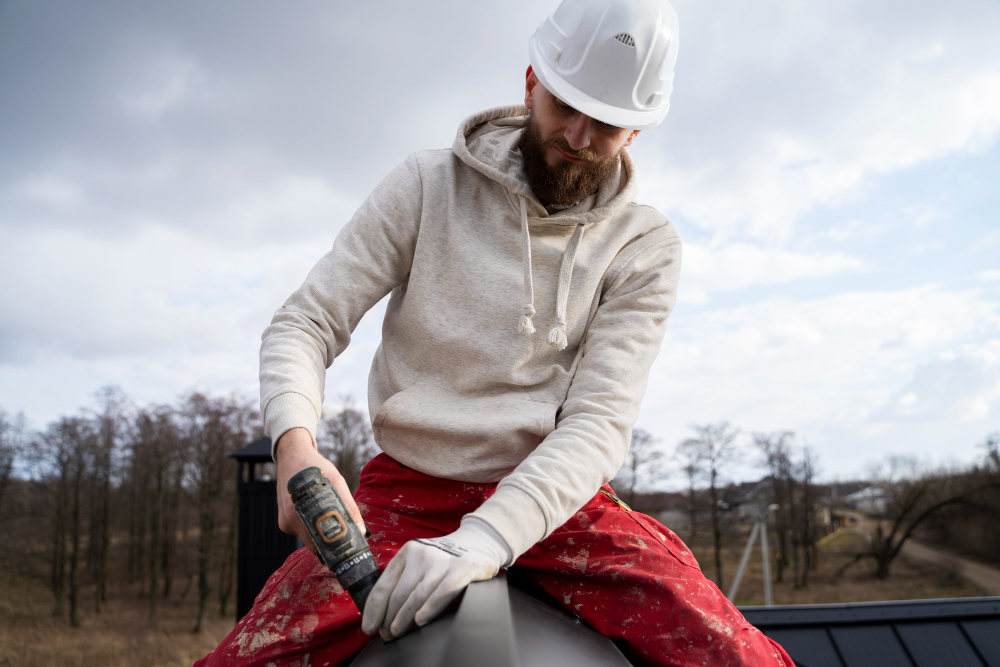When it comes to keeping your home comfortable year-round, roof ventilation often doesn’t get the attention it deserves. Yet, it’s one of the most critical elements in protecting your roof and your wallet. If you’ve ever asked, “What is a ridge vent, and do I really need one?”, you’re in the right place.
Table of Contents
Key Takeaways✔ A ridge vent allows hot, moist attic air to escape naturally for balanced roof ventilation. ✔ Proper ventilation can reduce cooling costs by up to 10% and extend roof lifespan. ✔ Homes should maintain a 1:300 ventilation ratio for optimal airflow efficiency. ✔ Ridge vents work best when paired with soffit vents for full-attic circulation. ✔ Professional installation ensures your ridge vent roof prevents moisture, mold, and heat damage. |
What Is a Ridge Vent?
So, what is a ridge vent? A ridge vent is a long, narrow ventilation strip installed along the peak (ridge) of your roof. Its job is to allow warm, humid air to escape naturally from your attic — without using electricity or noisy fans. When paired with soffit vents, it creates a balanced ventilation system that keeps air circulating year-round.
In a ridge vent roof setup, cool air enters through the soffit vents at the eaves, rises as it warms, and exits through the ridge vent at the top. This simple airflow system helps your roof “breathe,” reducing heat, moisture, and energy costs.
How a Roof Ridge Vent Works
The roof ridge vent system works through natural airflow principles — no motors, no maintenance, just smart design. Here’s how the process unfolds:
Intake
Cool, fresh air enters your attic through soffit vents near the roof’s edge. This air helps regulate temperature and replaces the hot air that rises and escapes through the ridge vent. Without proper intake, the ridge vent won’t work efficiently — balance is key.
Exhaust
As warm air rises, it exits through the ridge vent roof system, carrying heat and humidity out of the attic. This continuous movement prevents moisture buildup, which can lead to mold, wood rot, or insulation damage.
Wind Action
Wind plays a natural role too. When it blows across your roof ridge, it creates a slight suction effect that pulls warm air out even faster. This wind-driven exhaust keeps the air flowing smoothly through your attic without the need for electrical fans.

Why Roof Ridge Vents Are Important
Installing ridge vents can help maintain a healthier roof, lower energy costs, and extend the life of your home.
Preventing Moisture Damage and Mold
Poor ventilation traps humid air in your attic. Over time, this moisture can lead to mold growth, warped wood, and even ceiling stains. A ridge vent roof system allows continuous airflow, helping to keep your attic dry and preventing long-term structural damage.
Improving Energy Efficiency
When your attic overheats, your air conditioner works overtime. By releasing trapped heat through the roof ridge vent, your HVAC system doesn’t have to push as hard — which means lower energy bills and a more comfortable home.
Extending Roof Lifespan
Excess attic heat can cause shingles to blister and crack. Proper ventilation through ridge vents helps regulate roof temperature, preserving your shingles and adding years to your roof’s lifespan.
When to Use a Ridge Vent
Knowing when your home needs a ridge vent can prevent serious (and expensive) problems down the road. Watch for these common signs:
Extremely High Energy Bills
If your summer cooling costs are climbing, your attic could be trapping heat. A roof ridge vent releases that trapped air, keeping temperatures balanced and reducing HVAC strain.
Water Damage or Mold
Moisture in the attic often points to poor ventilation. If you notice moldy smells or damp wood, a properly installed ridge vent roof can help dry things out and prevent further damage.
Cracked or Curling Shingles
When attic temperatures soar, shingles age prematurely. Installing ridge vents helps regulate heat and protect your roofing investment.
Ice Dams
In cold Pleasant Valley winters, warm attic air can melt roof snow, which then refreezes at the eaves — forming destructive ice dams. Ridge vents keep attic temperatures stable, reducing the risk of ice dam formation and roof leaks.
Do Ridge Vents Replace Attic Fans?
Not exactly. While ridge vents and attic fans both help with ventilation, they work differently. Ridge vents rely on natural airflow, while attic fans use electricity to pull hot air out.
When installed properly, a roof ridge vent often eliminates the need for attic fans because it maintains constant, even airflow without added energy costs or mechanical wear.
In addition, a continuous ridge vent, when paired with soffit vents, creates a balanced, whole-attic airflow system.
When Should You Not Use a Ridge Vent?
Although ridge vents are ideal for most sloped roofs, they’re not suitable for every home. You should avoid them if:
- Your roof has a flat or very low slope, as airflow can’t circulate properly.
- Your home already has gable or turbine vents that could interfere with ridge vent performance.
A certified roofing contractor, like Roofer of Pleasant Valley, can assess your attic and roof design to determine whether a ridge vent roof system is the right choice.
Do All Homes Need a Ridge Vent?
Most sloped-roof homes benefit from having ridge vents, especially in climates like Pleasant Valley, NY, where temperature extremes can cause moisture buildup. However, not all homes require them.
According to most building codes, homes should maintain about 1 square foot of ventilation for every 300 square feet of attic floor space—known as the 1:300 ventilation ratio
How Long Does a Ridge Vent Last?
A quality ridge vent can last as long as your roof — typically 20 to 30 years. Weather exposure, debris buildup, and poor installation can shorten the lifespan of a ridge vent roof, so it’s best to have it checked during regular roof maintenance visits. With proper care, your ridge vents will keep air circulating efficiently for decades.

Frequently Asked Questions (FAQs)
Can a ridge vent be added to an existing roof?
Yes. A ridge vent can be installed on an existing roof during a minor upgrade or repair. However, it’s best done by a professional roofer to ensure the vent aligns properly with your roof’s ridge and works effectively with existing soffit vents for balanced airflow.
Do ridge vents work without soffit vents?
Not very well. A ridge vent roof relies on soffit vents to bring in fresh air while hot air escapes through the ridge. Without intake vents, airflow becomes restricted, reducing the roof ridge vent’s effectiveness in preventing heat and moisture buildup.
Are ridge vents noisy during strong winds or storms?
No, ridge vents are designed to operate quietly even in high winds. Unlike turbine or powered fans, a roof ridge vent has no moving parts, so you won’t hear rattling or whirring—just steady, natural ventilation.
How do I know if my ridge vent is working properly?
Signs of a functioning ridge vent roof include a cooler attic in summer, fewer moisture issues, and even shingle wear across the roof. If you still notice humidity or uneven temperatures, your ridge vents might be blocked or undersized and should be inspected.
Are ridge vents suitable for metal or asphalt roofs?
Yes, ridge vents work effectively on both metal and asphalt roofs. They’re available in designs compatible with various roofing materials, ensuring your roof ridge vent provides efficient ventilation no matter your roof type.
Ready to Improve Your Roof’s Ventilation?
A professionally installed ridge vent can make your home more energy-efficient, comfortable, and durable for years to come.
Don’t wait until small ventilation issues become expensive repairs — let the experts at Roofer of Pleasant Valley help. Contact us today to schedule your roof inspection or get a free quote!

